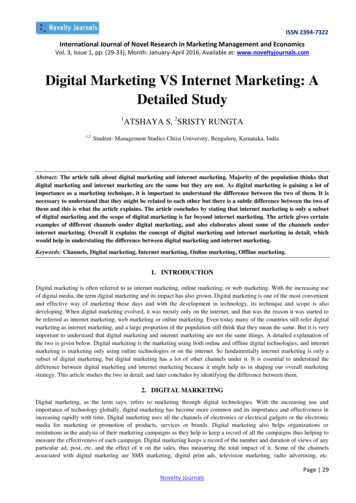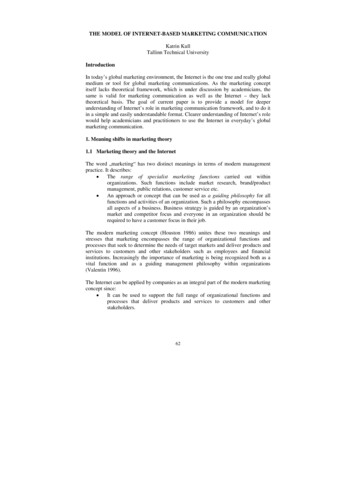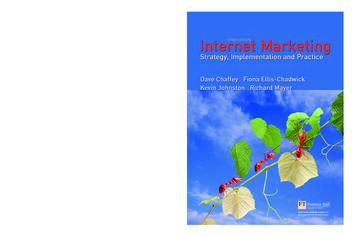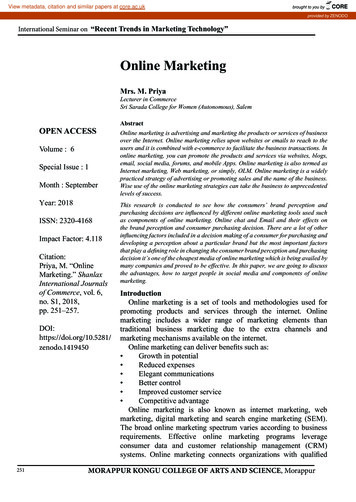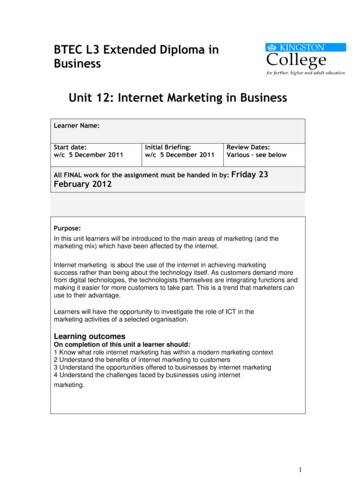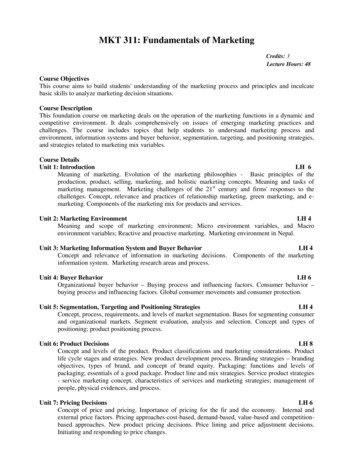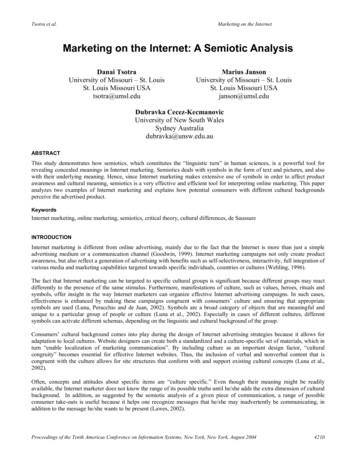
Transcription
Tsotra et al.Marketing on the InternetMarketing on the Internet: A Semiotic AnalysisDanai TsotraUniversity of Missouri – St. LouisSt. Louis Missouri USAtsotra@umsl.eduMarius JansonUniversity of Missouri – St. LouisSt. Louis Missouri USAjanson@umsl.eduDubravka Cecez-KecmanovicUniversity of New South WalesSydney Australiadubravka@unsw.edu.auABSTRACTThis study demonstrates how semiotics, which constitutes the “linguistic turn” in human sciences, is a powerful tool forrevealing concealed meanings in Internet marketing. Semiotics deals with symbols in the form of text and pictures, and alsowith their underlying meaning. Hence, since Internet marketing makes extensive use of symbols in order to affect productawareness and cultural meaning, semiotics is a very effective and efficient tool for interpreting online marketing. This paperanalyzes two examples of Internet marketing and explains how potential consumers with different cultural backgroundsperceive the advertised product.KeywordsInternet marketing, online marketing, semiotics, critical theory, cultural differences, de SaussureINTRODUCTIONInternet marketing is different from online advertising, mainly due to the fact that the Internet is more than just a simpleadvertising medium or a communication channel (Goodwin, 1999). Internet marketing campaigns not only create productawareness, but also reflect a generation of advertising with benefits such as self-selectiveness, interactivity, full integration ofvarious media and marketing capabilities targeted towards specific individuals, countries or cultures (Wehling, 1996).The fact that Internet marketing can be targeted to specific cultural groups is significant because different groups may reactdifferently to the presence of the same stimulus. Furthermore, manifestations of culture, such as values, heroes, rituals andsymbols, offer insight in the way Internet marketers can organize effective Internet advertising campaigns. In such cases,effectiveness is enhanced by making these campaigns congruent with consumers’ culture and ensuring that appropriatesymbols are used (Luna, Peracchio and de Juan, 2002). Symbols are a broad category of objects that are meaningful andunique to a particular group of people or culture (Luna et al., 2002). Especially in cases of different cultures, differentsymbols can activate different schemas, depending on the linguistic and cultural background of the group.Consumers’ cultural background comes into play during the design of Internet advertising strategies because it allows foradaptation to local cultures. Website designers can create both a standardized and a culture-specific set of materials, which inturn “enable localization of marketing communication”. By including culture as an important design factor, “culturalcongruity” becomes essential for effective Internet websites. Thus, the inclusion of verbal and nonverbal content that iscongruent with the culture allows for site structures that conform with and support existing cultural concepts (Luna et al.,2002).Often, concepts and attitudes about specific items are “culture specific.” Even though their meaning might be readilyavailable, the Internet marketer does not know the range of its possible truths until he/she adds the extra dimension of culturalbackground. In addition, as suggested by the semiotic analysis of a given piece of communication, a range of possibleconsumer take-outs is useful because it helps one recognize messages that he/she may inadvertently be communicating, inaddition to the message he/she wants to be present (Lawes, 2002).Proceedings of the Tenth Americas Conference on Information Systems, New York, New York, August 20044210
Tsotra et al.Marketing on the InternetSemiotics, which constitutes the “linguistic turn” in human sciences, is a particularly powerful tool for uncovering concealedmeanings of Internet marketing, due to the fact that online marketing involves symbols, such as written words and pictures.In addition, semiotics examines how people form perceptions that are products of the surrounding culture in whichrespondents live and participate. Culture, as far as semiotics is concerned, is the way people communicate, both consciouslyand unconsciously, through cultural aspects, such as visual images and language. Understanding the implicit meaning of suchelements, allows Internet marketers to make “informed decisions” and communicate more efficiently with potentialconsumers (Lawes, 2002).This article analyzes the figurative and cultural elements of two distinct Internet advertisements. This is accomplished byexamining elements of background, color, and form so as to obtain understanding and creation of reality in spatially restrictedsettings, such as the computer screen. We demonstrate that semiotics can be effectively applied to both traditional andInternet marketing and can benefit designers who want to create aesthetically pleasing and effective advertising promotions.The remainder of the paper is organized as follows: Section 2 discusses semiotics as a research methodology. Section 3describes two Internet advertisements. Section 4 analyzes these two advertisements from a semiotic perspective. Section 5discusses findings and philosophical implications. Section 6 is the paper’s conclusion.RESEARCH METHODThis section first introduces semiotics and several related concepts such as bricolage and bricoleur. Next, it presents themodel used in our analysis.SemioticsUmberto Eco (1976) stated that “semiotics concerns everything that can be perceived as a sign.” Signs constitute printed andspoken words, images, sounds, gestures, and objects. Individuals interpret signs as “signifying something.”According to Peirce (1894), “nothing is a sign unless it is interpreted as a sign”. This interpretation process occurs by relatinga sign to familiar systems of conventions and, hence, the sign becomes part of an organized collective of interactions andcannot exist outside such a collective. Signs function as a code between individuals and they trigger or “unlock” previousexperiences (Cobley and Jansz, 2000). In short, a human being functions as a “homo significans,” that is to say, as ameaning-maker who uses signs to receive, understand, and convey information.Interpretation and understanding of signs involves physical elements of objective existence (e.g., American stop sign), whichlead to some type of common understanding (i.e. stop the vehicle). This type of common understanding is usually derivedfrom socially accepted norms and rules. Hence, the hexagonal American stop sign creates a system of connotations thatindividuals have learned to perceive as part of everyday reality and social norms (Figure 1).Figure 1. The American Stop SignBy reading the above paragraphs, it seems evident that semiotics has certain similarities with hermeneutics, since both aim atmeaning creation. However, by reflecting on the definitions of these two methods, it follows that, although similar in theirpurpose, semiotics and hermeneutics differ in important ways. Ricoeur (1981), for example, stated that “hermeneutics is thetheory of the operations of understanding in their relation to the interpretation of texts.” Moreover, as Nőth (1990) pointedout, hermeneutics, by being one of the earliest methods of text interpretation, is a precursor of the present day semiotictheory. Semiotic theory studies sign systems of any kind, including written texts, logos, films, or forms of behavior (Floch,2001). Consequently, as Internet marketing makes use of text and graphics, we decided that semiotic theory was the propermethod for our analysis. In relation to online environments, the way consumers perceive online elements is an issue notthoroughly examined in the Information Systems literature and to which semiotic analysis can clearly contribute.Proceedings of the Tenth Americas Conference on Information Systems, New York, New York, August 20044211
Tsotra et al.Marketing on the InternetIn summary, semiotics, by studying signs, deals with the construction and maintenance of reality so as to avoid reverting to aset of mere physical artifacts - solely described in terms of rules, forms, shapes, sounds and colors. Furthermore, semioticsenables the altering of everyday reality by adding subjective understanding and a possibility to make subjective what wouldotherwise seem universal (if the individual’s experience and his/her unique way of thinking were absent.)A Model of SemioticsDe Saussure (1965) proposed a semiotic model in the form of a dyad, comprised of a signifier and a signified. The signifiermay consist of actual objects such as background or lines, whereas the signified is the concept in someone’s mind. Thedistinction between the signifier and the signified can also be expressed in terms of form and content (Chandler, 2002).A particular signifier/signified combination does not exist in isolation but needs to be combined with other signs in order toenable a definitive understanding of what is the signifier and what is the signified. In summary, de Saussure (1965) proposeda “structural” semiotic model. A stop sign exemplifies these ideas - the sign includes a hexagon, white letters, and redbackground as signifiers, whereas the driver obtains the signified in the form of the obligation to stop the vehicle.A concept that applies to semiotics was introduced by Levi-Strauss (1983) under the name of “bricolage.” “Bricolage”represents the process of creation by using materials that are not necessarily best-adapted to the task in hand. Instead,“bricolage” constitutes an eclectic dialogue among available materials, thus suggesting adaptive courses of action, wherebythe “bricoleur” (the initiator of the “bricolage”) might even modify his/her initial aim. With respect to semiotics, bricolage isthe process of interpreting symbols and signs using available cultural aspects. If the required aspects are not available, peopleadjust or modify existing ones (Floch, 2001).In order to construct new arrangements, the “bricoleur” works with signs, by adopting existing signifieds as signifiers and bychoosing from limited possibilities. A “bricoleur”, in other words, is someone who "tinkers,” by actually using tools not fortheir designed purpose but only as seems fit. Furthermore, the “bricoleur” always includes parts of his/her self when facingthe choice of what material to call up for modification, reinterpretation and adjustment to his/her way of thinking. In thecontext of interpretation, semantic nihilism cannot exist if the bricoleur/interpreter properly adopts and accepts the role ofcreating new, individually-understood and individually-initiated meanings of one or more signs.A SEMIOTIC ANALYSIS OF TWO INTERNET ADVERTISEMENTSThe analysis focuses on two mobile phone advertisements by Nokia of Finland (http://www.nokia.fi/) and by Ericsson ofSweden (http://www.ericsson.com/se/) (Figure 2). The specific advertisements were found in the companies’ websites andare a convenient sample, chosen due to the fact that both companies are global telecommunications companies, among thebiggest in the world, with contrasting messages towards the consumers (as the analysis will show). In addition, one of theauthors spent a considerable amount of time in Finland and was struck by the different messages associated with these twoadvertisements. It should also be mentioned that these ads are also used by the companies in the physical world as well, a factthat proves that both, Nokia and Ericsson, do not separate their online from their more classic advertisements.These two Internet advertising instances are analyzed using semiotic principles. Acting as “bricoleurs,” we analyze theexternal characteristics and forms of these two advertisements, with the aim of constructing meaning. The point of interest ishow the components of the two advertisements stand for something else, along with the social norms and group experiencethat they represent. After a general description of the two advertisements, we then focus on specific elements such asbackground, color and form.Proceedings of the Tenth Americas Conference on Information Systems, New York, New York, August 20044212
Tsotra et al.Marketing on the InternetFigure 2. The Nokia advertisement (on the left side) and the Ericsson advertisement (on the right side)The Nokia advertisement features the following parts: 1) the actual physical object (i.e. Nokia phone), 2) an imagecomprising two hands extending towards each other, and 3) the brand name that appears twice. A schematic of the Nokiaadvertisement is shown in Figure 3. As Floch (2001) noted, traces of concrete reality refer directly to normal, everyday life,as it is experienced without any effect of advertisement. Because the phone is depicted against a completely whitebackground the advertisement fails to produce an effect of “concrete” reality.The Ericsson advertisement features the following primary parts: 1) the actual physical object (i.e. Ericsson phone), 2) animage on the phone’s screen stating “welcome home 12-June 19:03,” and 3) the name “Ericsson” on the phone’s screen(Figure 4). Moreover, the advertisement features secondary parts that affect “concrete” reality such as a wooden table with acutting board, tomatoes, bread, a metal object, and a yellow object in the right hand lower corner that looks like a bottle ofoil. These items constitute concrete reality because they all are everyday, easily recognizable and identifiable objects and canbe understood properly even outside the advertisement context. Thus, for example, the tomatoes are perceived as tomatoesregardless of whether they appear in Ericsson advertisement or not.An in-depth semiotic study should focus on the advertisements’ images and background. The Nokia advertisement forwardsthe phone’s image in favor of its background. A close reading of the two hands is suggestive of the hand of a parent reachingout to his or her child. In short, these elements draw attention to Nokia’s stated mission, which is “connecting people” andpresumably families (Figures 2 and 3).The Ericsson advertisement shows the time as three minutes after seven in the evening, the date as June 12, and further states“welcome home.” The time and the statement “welcome home” suggest the end of the work day when family members returnhome for dinner. Moreover, by stating “June 12,” the advertisement draws attention to summer and justifies the presence ofthe two seemingly fresh tomatoes (Figures 2 and 4).Proceedings of the Tenth Americas Conference on Information Systems, New York, New York, August 20044213
Tsotra et al.Marketing on the InternetThe Nokia AdvertisementThe part that produces an effectof the advertisement per seThe part that produces aneffect of concrete realityImage of phoneImage onscreenBackgroundPhysical objectBrand nameFigure 3. The Nokia AdvertisementThe Ericsson AdvertisementThe part that produces an effectof the advertisement per seThe part that produces aneffect of concrete realityImage of phoneMessageon screenBackground objectsPhysical objectBrand nameFigure 4. The Ericsson AdvertisementAs far as the existence of background is concerned, on the one hand, the Nokia advertisement lacks precise background, yetwe may consider the color white to function as background. One of the characteristics of white is that it is not alwaysperceived as a color, thus it helps other chromatic elements of the advertisement be more prominent to the eye. On the otherhand, the Ericsson advertisement has a set of background objects. These elements suggest preparation of a vigorous meal,containing healthy ingredients.The two advertisements also differ with respect to the use of color. On the one hand, in the Nokia advertisement, the coldblue color is prominent against white. The outstretched hands appear to belong to individuals of a white race. Overall, theuse of a white background and a cold color seem to create a cold, even austere atmosphere. The Ericsson advertisement, onthe other hand, features mostly yellow and red colors. Red attracts attention and, along with yellow, they are both warmcolors. Furthermore, the dark-colored phone appears prominent because it is portrayed against warm colors and also becauseit is mirrored on the silver metal object. Overall, the Ericsson advertisement casts a warm atmosphere.The two advertisements also feature different geometrical forms (Figure 5). The Nokia advertisement has a circular formfocusing on the way the two hands extend towards each other. The Ericsson advertisement features a triangular form, theProceedings of the Tenth Americas Conference on Information Systems, New York, New York, August 20044214
Tsotra et al.Marketing on the Internetbasis of which is the phone with the top of the triangle formed by the tomatoes. Finally, while in the Ericsson advertisementthere is mirroring of the phone on the metal object, in the Nokia advertisement mirroring is achieved by the two hands thatmirror each other as they extend.Figure 5. The circular form of the Nokia advertisement contrasted against the triangular form of theEricsson advertisementOn SemioticsThe semiotic study presented above uses objects, colors and shapes as elements of advertisement design. However, athorough semiotic analysis should delve beneath the aforementioned items and attempt to analyze context and, if possible,draw comparisons.The two hands in the Nokia advertisement recall the famous and religious painting the “Creation of Adam” by MichelangeloBuonarroti. The painting, which is on the Sistine Chapel ceiling of the Vatican, depicts God’s life-giving act. Thus, theNokia advertisement brings to mind God and Heaven, the miracle of creation, and the genius of Michelangelo (Figure 6). Theadvertisement’s colors play a special role. First, the blue and white colors remind one of heaven and sky and, by extension,they bring to mind a Superior Entity, thus referring back to Michelangelo’s painting. Alternatively, white is also the color ofthe snow and draws attention to the Finnish landscape that is covered by snow during most part of the year.Figure 6. “The creation of Adam” by Michelangelo (1508-1512)On visiting Finland and especially Northern Finland and Lapland in winter time, one is struck by the extreme beauty of thesky which, like a gigantic dome, hovers over vast fields and lakes covered with snow. However, despite the beauty, one alsorecognizes within oneself a strong feeling of forlornness and danger. Getting lost in this environment (i.e., for example duringProceedings of the Tenth Americas Conference on Information Systems, New York, New York, August 20044215
Tsotra et al.Marketing on the Interneta cross country ski trip) likely means death. As a visitor, one either hears or reads tales of people who, while skiing alone,were met with an accident and were saved because their mobile phone allowed calling for help.1 Within this context, theNokia advertisement acquires additional meaning since the two outstretched hands now suggest being given a new lease onlife. Pushing the image to its logical end, it seems that owning a Nokia phone may imply having a permanent stake in life.The various elements of the Ericsson advertisement suggest the end of the work day when people return to a relaxing familyenvironment at home. The colors and the date suggest warm summer days and simple pleasures such as a fresh, home-cookedmeal and a healthy lifestyle. The advertisement portrays a slice of everyday life and resembles a still life of which theEricsson phone is a natural part.The foregoing discussion is summarized by a comparison of the two advertisements using elements of de Saussure’s semioticmodel (Table 1). Furthermore, the two advertisements represent different visual categories that enhance the effects mentionedabove (Table 2). Finally, the two advertisements represent different levels of reality construction as evidenced by figurative,thematic and abstract levels (Table 3).Signifiers NokiaScreen elementsNokiaBackgroundColorFormMirroringImage of extending handsNokiaWhite colorCold colorCircular formExtended handsSignifiers EricssonScreen elements19:0313-JuneEricsson“Welcome home”BackgroundColorFormMirroringVarious everyday objectsWarm colorsBlack phoneTriangular fromArrowSilver objectSignifieds NokiaFamilyConnectednessEmphasis on the brand nameSkySnowWinterConnectednessCompletenessBringing people togetherConnecting peopleSignifieds EricssonEnd of work dayTime to prepare dinnerMiddle of summerWarm weatherEnd of work dayComing back homeHealthy dietAbout to eat a mealSummerEmphasis on the phoneEmphasis on the phoneEmphasis on the phoneEmphasis on the phoneTable 1. A semiotic analysis of the Nokia and Ericsson Advertisements1One of the authors is a frequent visitor to Finland and spent a seven month period in Oulu, Finland in 2000.Proceedings of the Tenth Americas Conference on Information Systems, New York, New York, August 20044216
Tsotra et al.Marketing on the InternetVisual categoriesForm/mirroringColorsVisible messageSemiotic categoriesNokiaEricssonCircleColdImageHigher levelFamilyMankindAbility to connectTriangle / arrowWarmLettersHuman levelHealthy, natural lifestyleBright, enjoying lifeTable 2. Visual and semiotic categories of the Nokia and Ericsson AdvertisementsNokiaAbility to connectGeniusCreation/miracleFigurative levelThematic levelAbstract levelEricssonSimple natural lifestyleFeeling of homeBelongingnessTable 3. Construction of reality in the Nokia and Ericsson AdvertisementsHowever, we can also take our analysis yet one step further by contrasting the two advertisements using a semiotic square(Figure 7). Nokia’s and Ericsson’s advertisements are depicted on the left and right side, respectively. Nokia’s phoneadvertisement symbolizes a sky and Not Earth relationship whereas Ericsson’s phone advertisement symbolizes an earth andNot Sky relationship.ContrarietyEarthContradictionNot NNot SkyContrarietyFigure 7. A semiotic square: Nokia versus EricssonFurthermore, Nokia’s phone symbolizes Michelangelo’s genius and the extraordinary (Figure 8). It suggests, in a subtlemanner, that anyone acquiring a Nokia phone is associated with genius and simultaneously is placed in an extraordinarycategory. Ericsson’s phone, on the other hand, symbolizes everyday life and normality. It suggests, in a subtle manner, thatanyone acquiring an Ericsson phone is performing a sensible act considered normal under the circumstances. The Finnishadvertisement projects the phone into a mythical category whereas the Swedish advertisement classifies the phone as aneveryday and mundane appliance.Proceedings of the Tenth Americas Conference on Information Systems, New York, New York, August 20044217
Tsotra et al.Marketing on the InternetContrarietyGeniusExtraordinary[not mentarityNOKIADull[everyday life]ERICSSONNormal[not genius]Figure 8. A semiotic square: Nokia versus EricssonAsemioticanalysis also enables the use of culture in order to disconnect and reconnect spaces. The Ericsson advertisement, for example,seems closer to the Mediterranean climate, bright sunshine and colors, a natural life style with healthy food (tomatoes, oil,and home-made bread) and simple pleasures, where family and home are important aspects. Generally speaking, thisadvertisement seems to reflect the recent tendency in the Swedish culture to return to a healthier/natural lifestyle and way ofliving (as stated in a Swedish tourist website http://www.sverigeturism.se)Furthermore, the Ericsson advertisement also reflects the company’s ideology in terms of the ability to use the phone whiledoing other things and enjoying “colorful, easy-to-use” services:“Doing the laundry playing with the kids sitting in traffic, knowing where you are in faraway townsin the busiest of streets enjoying mysteries, love stories, soaps and playing games, solving puzzles,glimpsing life-changing news, organizing a life lived seamlessly on the move every moment of everyday around the world, around the clock.” (http://www.ericsson.com)The Nokia advertisement suggests that communication is a sacred activity of connecting in a mythical and non earth likeenvironment. Hence it is no surprise that Nokia’s stated mission is expressed in the slogan “Connecting People.”Nokia’s advertisement also echoes Finland’s survival as a nation. 2As noted by Lyytinen and Goodman (1999):“The prominent features of the Finnish military organization were organic forms, improvisation, individualreliability and responsibility, and fast reaction.”According to these authors, Finnish social values are dominated by the values expressed in the above quote. Indeed, Nokiahas a flat hierarchical organization that enables quick action and where workers can improvise (Lyytinen and Goodman,1999). It is evident that the Nokia advertisement reflects aspects of Finland’s cultural history as well as national pride.As a general conclusion, it is interesting to notice that both countries are geographically close (only separated by the Gulf ofBothnia), with similar climates, and with similar positions to the rest of Europe, and yet their cultures and marketingstrategies for the same products are entirely different.2Finland was a Swedish colony for several hundred years until the nineteenth century after which it became part of CzaristRussia. After being granted independence in 1917, Finland was attacked by the Soviet Union in what still today is known asthe 1939 “Winter War.” The Finns fought valiantly and almost succeeded in defeating the Soviet army.Proceedings of the Tenth Americas Conference on Information Systems, New York, New York, August 20044218
Tsotra et al.Marketing on the InternetOn Semiotics and PhilosophySemiotics promotes understanding reality as a system of signs by which humans actively create meaning in accordance withcodes of which they are normally unaware. These codes are present because individuals live in the society, both as creatorsand as users of the codes.We considered Internet marketing in terms of semiotic activities that function by creating meaning. Even though Internetadvertisement designers and webpage creators do not have the caliber of Michelangelo, they face similar dilemmas: Shouldthe message be metaphor-based in a way that consumers/viewers will be able to grasp directly or should one create new waysof interpreting messages at an unconscious level? In short, how and to what extent are website designers able to controlmeaning creation, given a vaguely subjective resemblance between the sign and the perception related to it?Internet marketing designers as well as viewers of Internet marketing practices seem to act as “bricoleurs.” First, the Internetmarketing designer uses existing semiotic codes in unusual ways so as to create new meanings. Second, the viewer usesexisting semiotic codes in innovative ways to interpret the Internet marketing website. It goes without saying that the websitedesigner wants the viewer to interpret his/her message in the manner intended.In light of Internet marketing operations and actions, it can be argued that “a good tool makes users direct their attentiontowards the object of the work while the tool itself disappears” (Bodker, 1987). Put differently, the tool is handled byunconscious operations, while the work object is manipulated by conscious actions. In the case of Internet marketing, thebrowser is the tool. Once the user manages to detach himself/herself from this fact, what remains is the individual’sunconscious and instinctive reaction to signs. This statement does not diminish the importance of social codes. However, wesuggest that social learning can be conscious, only to become an unconscious source of knowledge and direction later on.The semiotic analysis presented above leads to concerns that are better addressed by critical theory. If one defines a good toolas one that is used subconsciously, the question that arises is whether Internet advertisements empower, emancipate, orsubjugate viewers. As explained above, the Nokia website advertisement reaches the observer at a deep level along severaldimensions – spiritual, metaphysical, mythological, cultural, and nationalistic in nature. Perhaps it would be correct to statethat owning a Nokia phone empowers individuals, however, the manner of advertising the Nokia phone subjugates viewers.Website advertisements can present the signified in a distorted manner and, hence, users are well advised to be suspiciousand critical, and to direct their attention towards the meaning producing mechanism. In short, users who have a rudimentaryknowledge of semiotics are in a more advantageous position to avoid being manipulated than those individuals who areignorant of semiotic mechanisms.CONCLUSIONOne of the advantages of Internet marketing is its ability to target promotion and marketing to audiences in new andinnovative ways. A thorough semiotic analysis of the elements and signs of a website advertisement shows that individualsbelonging to different cultural groups create meaning in different ways. Our semiotic study demonstrates that alternativevisual categories are relevant to different groups. Because semiotic categories affect perception even when perceivedunconsciously, the use of appropriate semiotic elements is essential to effective Internet advertisements.Furthermore, we should mention some limitations of the present research. We attempted to provide an introduction tosemiotics as a research method in the IS area, and we used two online advertisements to exemplify the applicability ofsemiotics. We were not interested in the overall marketing strategy of the company. In addition, we did not discuss thepossible effect of other onscreen elements that appear simultaneously with the advertisement (i.e. what percentage
Internet marketing and can benefit designers who want to create aesthetically pleasing and effective advertising promotions. The remainder of the paper is organized as follows: Section 2 discusses semiotics as a research methodology. Section 3 describes two Internet advertisements. Section 4 analyzes these two advertisements from a semiotic .


